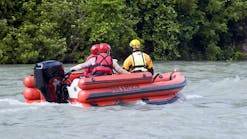Are you leveraging tech for optimal flood risk analysis?
Floods are some of the most pervasive and damaging weather events water systems have to deal with. They also have a complicated relationship with water infrastructure, as these systems can be one of the most heavily impacted targets of flooding and its cause in other cases. Either way, reliable flood risk assessments are essential.
While most utility organizations understand the importance of these risk assessments, many rely on outdated methods. The water management industry must embrace new technologies to improve this area and protect the populations it serves.
The need for better flood risk assessment
Before knowing what tech to capitalize on, one must first recognize why flood risk assessments need improvement. While the hazards themselves are nothing new, they are worsening. Roughly one-third of U.S. wastewater facilities are at risk of flooding if a severe storm hits — something that is becoming increasingly common with climate change.
Much of the nation’s water infrastructure was designed for a milder climate. Now that extreme weather events occur with rising frequency, these older systems are not as resilient as they once were. Detailed terrain models and more accurate risk alerts prevent the worst outcomes by enabling faster responses to developing emergencies.
Improved risk assessments are also crucial for long-term infrastructure upgrades. Modernizing aging water infrastructure in light of growing flood risks is essential, but the nation cannot replace its 2.2 million miles of water pipes simultaneously. Better risk analysis would reveal which areas most need upgrades, enabling smarter resource distribution.
Meeting these demands is only feasible with the right technology. Here is a look at some of the best tech for flood risk analysis.
The Internet of Things
The Internet of Things (IoT) is an excellent place to start. Many water companies already use these interconnected devices to monitor treatment facilities or watch for leaks. That same real-time data functionality makes them ideal for flood risk assessments.
In-pipe sensors can scan for cracks or other weak points that suggest a system may be vulnerable to flooding. Water pressure sensors and soil moisture monitoring provide similar insight. This data may not enable detailed terrain models, but it gives crucial context for infrastructure-related concerns that amplify flood risks.
As more water utilities implement IoT devices, they must remember to secure them. The Cybersecurity and Infrastructure Security Agency has warned of a trend of attacks against water infrastructure, particularly against integrated IT/OT systems, of which the IoT is part. Data encryption, strong password management and network segmentation can help.
Digital Twins
Digital twins — virtual models of real-world objects, systems and processes — are another promising technology. As water utilities gather more data from IoT devices and other scans, they can create in-depth digital twins of their pipelines and the surrounding environment. These models, in turn, enable highly detailed simulations.
Enterprises can simulate extreme weather events in digital twins to gauge the impact without expensive and disruptive real-world testing. Because digital twins rely on real-world data, they are often just as reliable as physical tests. It then becomes easier to gauge infrastructure’s flood risks accurately in less time.
This modeling applies to more than water infrastructure itself. Creating detailed terrain models of the surrounding environment lets groups determine if areas are prone to mudslides or other extreme events in a flood for more comprehensive risk assessments.
Machine learning
Utility companies wanting to make the most of their digital twins must also embrace machine learning. This is the branch of artificial intelligence (AI) that teaches AI models to learn from data.
Machine learning can draw conclusions from complex data sets faster and more accurately than manual methods. Pairing this technology with digital twins lets water organizations gain timely, relevant and actionable insights from these simulations. With the right data, machine learning can simulate debris flow or other factors to get a more accurate picture of flood risks.
In addition to surpassing humans’ ability to detect trends in large data sets, machine learning can perform this analysis faster. Consequently, it lets water utilities simulate multiple scenarios or assess many areas in far less time, enabling faster responses.
Predictive analytics
Predictive analytics is a more specific type of machine learning ideal for flood risk assessment. These AI models take what they have learned from past data to predict future events. Water companies can use it to get early warnings about incoming flood risks or determine which areas need attention first.
Some may use predictive analytics to monitor real-time weather data to alert them when conditions will likely cause a flood without intervention. Alternatively, utilities can use it to predict which pipelines are likely to degrade most rapidly to inform more relevant infrastructure upgrades.
In all cases, predictive analytics turns flood risk analysis from a reactive process to a proactive one. By getting ahead of future events, water authorities can prevent flood damage instead of merely responding to it.
Cloud computing
Not all flood risk assessment technologies are as advanced or exciting as machine learning. Cloud computing may not be as disruptive but is equally crucial as water companies embrace these other innovations.
These technologies have one thing in common — they either produce or require large amounts of data. Without a scalable and organized way to store that information, it will be difficult to use it to its full potential. Considering IoT devices alone are on track to generate 79.4 zettabytes of data by 2025, conventional, on-premise storage will quickly become insufficient.
Cloud storage can expand as necessary, enabling easier data growth. Water utilities can also consolidate all their data from different sources into one database in the cloud for more accurate machine learning analysis. By providing room for more data and ensuring it all stays together, cloud computing makes other risk assessment technologies more reliable.
Considerations for leveraging flood risk assessment technology
Using some or all of these technologies will help build detailed terrain maps and infrastructure monitoring systems for better flood risk analysis. However, utilities must keep some implementation best practices in mind to make the most of this technology.
Workforce barriers to tech adoption are the most significant obstacle, with nearly 90% of leaders citing recruiting or maintaining tech talent as a challenge. Organizations cannott use new technology effectively without relevant skills and knowledge. Amid a highly competitive tech labor market, upskilling is often the solution. Training current employees to use advanced technology may be easier and more effective than trying to hire outside talent.
New technology is also expensive. Groups can offset these costs by starting with the most impactful use case for their specific goals before expanding their tech investments. IoT monitoring and machine learning are often good places to start, as they yield more significant and sometimes immediate improvements.
Ensuring robust cybersecurity is also essential. Many of these technologies are data-centric, so their adoption could make water utilities larger targets to cybercriminals. Training is once again crucial, as 36% of workers today admit to making security-jeopardizing mistakes within the past year. Technical defenses like automated network monitoring and zero-trust security architecture are also important.
New tech creates more reliable risk assessments
As flood hazards rise, fast, accurate flood risk assessments become increasingly crucial. Water utilities must embrace new technologies like digital twins and the IoT to keep up with these mounting risks.
Tech adoption comes with plenty of challenges, but if organizations can navigate these obstacles, the long-term benefits are more than worth the disruption. These technologies may be the difference between security and catastrophe in a severe enough weather event.
Emily Newton | Editor -in-chief
Emily Newton is editor-in-chief of Revolutionized. Newton can be reached at [email protected].






